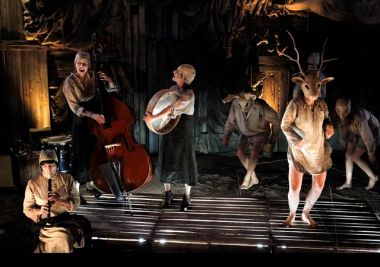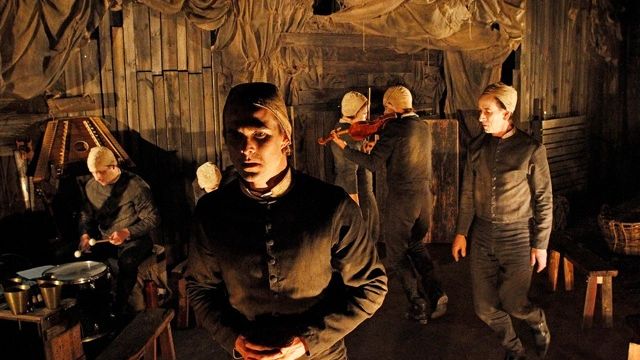Plague Dances
Plague Dances is a well-crafted, evocative and haunting work melded with the exquisite use of instrumentation and the singing voice.
Full marks must go to Malthouse for facilitating and nurturing the promising youthful team of theatre makers that is Four Larks. They have built a reputation working as creative spirits in ‘found spaces’. Now based in a conventional environment with a talented team of performers, they have fashioned another memorable offering in Plague Dances. Although it is less edgy and confrontational than I expected (having not seen their previous works), they have skillfully written, created and rendered beautiful experiential, broad themed theatre, for a small space - the Tower at Malthouse.
 Plague Dances is the story of a young woman Hannelore (Esther Hannaford), a stranger, who arrives in a Medieval Village. Under the protection of the priest (Kevin Kiernan-Molloy) she is inspected by the doctor (Matt Crosby), given a clean bill of health from the Bubonic Plague and conditionally allowed to remain in the community. Hannalore is a curiosity and a marvel as she has brought the sun with her. But she is also and an independent woman and, predictably, she must be contained and controlled.
Plague Dances is the story of a young woman Hannelore (Esther Hannaford), a stranger, who arrives in a Medieval Village. Under the protection of the priest (Kevin Kiernan-Molloy) she is inspected by the doctor (Matt Crosby), given a clean bill of health from the Bubonic Plague and conditionally allowed to remain in the community. Hannalore is a curiosity and a marvel as she has brought the sun with her. But she is also and an independent woman and, predictably, she must be contained and controlled.
In this representative community, a lack of scientific knowledge renders superstition as infectious as any virus. Throughout we witness calculation and manipulation that highlights the ruthless fight for survival in Medieval Times.
The Tower Theatre is completely transformed to into an atmospheric Medieval environment by set designers Ellen Strasser and Sebastian Peters-Lazaro. This excellent command of space, right down to the hessian covered auditorium seats, enhances the sense of impoverishment and hardship of the era, whilst, the costuming (Ellen Strasser) suggests the repression of the Salem Witch Hunts.
 Choreographically (Sebastian Peters-Lazaro), the whole is skillfully coordinated and structured and economically staged incorporating smooth and flowing set changes that are deftly executed buy a proficient ensemble of performers and musicians. An ingenious use of soil is exquisitely managed and the ‘Danse Macabre’ is reduced to a very effective succinct contorted writhing.
Choreographically (Sebastian Peters-Lazaro), the whole is skillfully coordinated and structured and economically staged incorporating smooth and flowing set changes that are deftly executed buy a proficient ensemble of performers and musicians. An ingenious use of soil is exquisitely managed and the ‘Danse Macabre’ is reduced to a very effective succinct contorted writhing.
The lighting by Tom Willis assists in delineating various environments and enhances the ambiance with some cleverly positioned light sources.
For me and perhaps others of my generation Plague Dances is reminiscent of Whistling In The Theatre’s work in the late 1980’s – early 90’s at Napier Street.
Over all, on opening night, I experienced Plague Dances as earnest, and a little too introspective in its delivery by most performers. This, I think, is because the depth of meaning in this wonderfully ambitious work had, not yet, been fully teased out. I feel sure that with every performance in its very short season, Plague Dances will develop and become more nuanced as the performers relax more fully into the experience and engage more strongly with their audience.
Suzanne Sandow
Photographer: Jeff Busby.
Subscribe to our E-Newsletter, buy our latest print edition or find a Performing Arts book at Book Nook.

